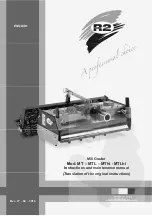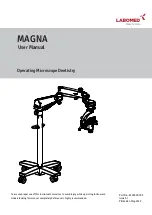
VRC4500/5000 VERTICAL WINDLASS
OPERATION
6
BOLT TORQUES
It is important that all bolts are tightened appropriately to ensure service reliability and structural integrity. The
following are suggested torque/preload values for the general bolt sizes found on Muir Windlasses. Muir also
recommends the use of thread locking compounds on threads to reduce loosening and corrosion.
Bolt Tightening Torque and Pre Load
Stainless Steel Class 70
M8
M10
M12
M16
M20
M24
Tightening Torque (Nm)
16.6
35
61.2
152
296.4
512.8
Pre Load (Nm)
10.8
17.2
25
46.6
72.7
104.8
LOWERING THE ANCHOR
It is important that the windlass operator understands
the operation and safety instructions included before
controlling the equipment supplied to ensure safe,
correct and efficient use. Always keep clear of running
gear and chain when operating.
The windlass can be powered up and down; this gives
the option of using the power system to release the
anchor chain, or by releasing the clutch and controlling
the chain release with the brake band.
Before attempting to lower the anchor by the free
wheel method, apply the brake, ensure the gypsy is
disengaged by rotating the clutch nut in an anti
clockwise direction until the dog clutch is clear. The
chain stopping device can now be disengaged (if
fitted), check the area is clear then proceed to lower
the chain and anchor by slowly releasing the brake
and using the brake to control the rate of descent.
Once the anchor is set at the required depth the brake
must be tightened and the chain stopper must be
engaged to take the load off the windlass while at
anchor.
If powering down, engage the clutch drive by turning
the hand wheel in a clockwise direction until the clutch
is engaged, release the brake band by turning the
handle anti-clockwise.
When using the brake, it is first necessary, after
ensuring the brake is applied (turning the handle
clockwise), to release gypsy drive by rotating the
windlass clutch, with the lever handle, anticlockwise.
This applies to both cone and dog clutch.
A chain stopping device must be fitted forward of the
windlass to take the mooring load off the windlass as
this will result in serious damage being done to the
winch.
By slowly releasing the brake the fall of the anchor can
be controlled. Once the anchor is set at the required
depth the gypsy pawl or chain lock ( if fitted) and brake
band can be tightened. It is recommended that a chain
lock be fitted forward of the windlass to take the load
off the windlass main shaft. Do not leave the anchor
load directly on the running gear as this may result i8n
serious damage to the drive gears. Always ensure the
chain lock then the brake band takes the load in that
order.
If this is not possible use a snubber line forward of the
windlass to take loading off the windlass. Make sure
that the brake is fully engaged while at anchor.
RETRIEVAL
Before lifting the anchor ensure the clutch and brake
are fully engaged and locked into position before
releasing chain securing device. Engage the clutch by
tightening the clutch top (turn the lever handle
clockwise). The anchor can now be raised by
operating the control.
Clutch Operation
To ensure correct engaging of the dog clutch is as
follows:
1. Ensure the four drives are aligned correctly
and will not contact when the clutch is
engaged. This can be done in two ways:
-By utilizing the controls to inch the windlass,
or by using the brake to correctly align the
drive.
2.
Engage the drive by turning the clutch nut
clockwise until they are fully engaged.
3.
Slowly slacken the brake to allow the gypsy to
rotate. This will allow the faces of the drive to
contact and become fully engaged
4.
When engaged the brake may be slackened
fully and windlass operated.
The above functions will allow the drive to be
successfully engaged to operate the windlass in the
recovery operation to retrieve the chain. Should the
windlass be required to lower the chain the above
functions must be reversed.
Summary of Contents for VRC4500
Page 9: ......



























